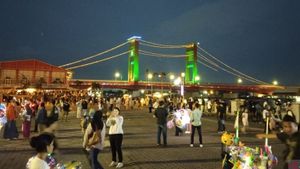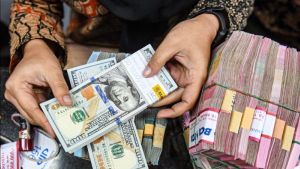JAKARTA - In Indonesia, where most of the people are Muslim, the pilgrimage is so important. In addition to fulfilling the pillars of Islam, the pilgrimage is a marker of a person's social status in society. In an economic context, Hajj has also become a business, even since the days of the Dutch East Indies. Dear. Not all of these businesses are carried out properly. Various problems overshadowed the problem of the pilgrimage in the Dutch East Indies era.
In those days the pilgrimage caused intense business competition. Because of its tightness, the pilgrimage is often marked by acts of fraud, from monopoly to fraud. In the late 19th and early 20th centuries, the pilgrimage in the Dutch East Indies was marked by a strong business monopoly by private Haj travel agencies. This monopoly was approved by the Dutch East Indies government through the granting of permits, so many congregations were harmed.
In the context of deception, this practice has plunged many pilgrims into slavery. Others, related to giving the title of fake hajj to congregations who have not even reached Makkah. So many forms of irregularities in the management of the pilgrimage at that time.
Even so, it is not known exactly when Muslims in the archipelago began to perform the pilgrimage. However, there is one name that goes down in history as the first person from the archipelago to go on Hajj. He is Prince Abdul Dohhar, son of Sultan Ageng Tirtayasa from Banten. He went to the Hajj in 1630.
In the following years, more and more people went on the pilgrimage. The worship tradition has even developed into an educational tradition. People who originally went to Mecca only for the pilgrimage then took part in studying Islam. After returning from Mecca, those people brought religious knowledge and taught it in the country.

Pilgrims from Banten while in Makkah in 1890 (Source: KITLV Leiden)
The challenges of the pilgrimage are getting heavier from year to year. Quoted from the book Collection Written by Snouck Hurgronje Volume VIII by Soedarso Soekarno, one of the challenges faced by the pilgrims at that time was worship which took a long time.
At that time, before there were steamships, the congregation left for the pilgrimage using sailboats to Aceh. From there they boarded a merchant ship for India. There was no ship that immediately took them to Makkah. After from India, they continued their journey by boat to Yemen. If they were lucky, they got a boat straight to Jeddah.
This route can take half a year at a time. Another obstacle that had to be faced by the pilgrims was the sinking of the ship on which the ship was carrying, which resulted in the ship's passengers drowning or stranded on the island. There are also pilgrims whose belongings have been robbed by pirates or have even looted their property by the crew of the ship itself so that their intentions for Haj have run aground.
The pilgrimage journey from the Dutch East Indies began to be facilitated when the Suez Canal was built in 1869. At that time the number of steamships departing the Dutch East Indies for Jeddah was getting more and more crowded. Not only those who have hajj but also those who live in Makkah. As a result, the number of pilgrims who returned to the country was more than those who departed.

This condition raised concerns for the colonial government. Quoted from the book Encyclopaedie van Nederlandsch Indie by EJ Brill and Martius Nijhoff, the authorities in the Dutch East Indies at that time could not supervise the activities of the Dutch East Indies population outside of the haj pilgrimage. At that time the thought of Pan Islamism in the Middle East was on the rise.
The Dutch East Indies government was worried that these ideas would enter the colony and create resistance movements in society. Finally, the Dutch East Indies government opened a consulate in Jeddah in 1872. In addition, the Dutch East Indies government also began to directly handle the pilgrimage process, from departure to return to the country.
At first everything went well. But as the pilgrims boomed, the ships of the Dutch East Indies government were no longer able to carry them. The next decision is to involve the private sector. However, this involvement created new problems. Quoted from the book Hajj Travel Bureau in Colonial Indonesia: Agent Herklots and Firm Alsegoff & Co published by the National Archives of the Republic of Indonesia (ANRI), it is explained that the door was opened wide for the private sector to get involved in handling the pilgrimage with bad consequences.
The private parties took the opportunity to make excess profits, exceeding the intentions of worshiping the congregation. This excessive economic orientation has resulted in chaos in the departure of the hajj by the private sector. Brokers appeared. They are the ones assigned to find as many potential pilgrims as possible.
If the target is achieved, the brokers will receive a reward from the private sector, namely leaving for Jeddah for free. On the boat, the activities of these brokers do not stop. They become brokers for congregational lodging in the Holy Land. Of course they asked for additional money from the congregation. For the congregation who is very rich, this problem is easy. But this is not the case for congregations with just barely enough money.
To meet the payment, brokers used to persuade the congregation to sell mediocre items of value for very little nominal. In fact, many congregants were extorted of their property so that they could not continue the pilgrimage in Makkah. The money for the congregation is often only enough for the trip to Singapore. Victims of such fraud are referred to as the "Singapore Haj."
Apart from extortion, private Hajj departure agents are also involved in a lot of fraud. One of the depravity that was most highlighted by the colonial government was that of the Hajj travel agency, Herklots and the Alsegoff Firm.
Extortion and the Herklots Fraud
The establishment of a pilgrimage travel agency, Herklots, was initiated by YGM Herklots. He is an Indo-European who was born in Java. Herklots did business by painting ships. Herklots' activities began when he left for Jeddah on February 27, 1893. At that time he left for Jeddah on behalf of the Knowles & Co Firm in Batavia.
In running his cunning business, he was assisted by his brother, WH Herklots. Arriving in Jeddah, the Herklots brothers set up their own pilgrimage bureau. After obtaining permission from the local government, the bagged legality further paved the way for the Herklots brothers to make profits through the holy ritual of the pilgrimage. You do this by asking for additional money from the congregation outside of a predetermined cost.
Herklots' business relations are also growing in the Holy Land. When he was having trouble with funds, a Kabah manager named Syeikh Abdul Karim managed to help him get a loan from the ruler of Makkah, Amir (Syarif Besar). To the authorities, Herklots claimed that his name was Haji Abdul Hamid. With this kibul technique, Herklots received funding of 150 thousand guilders.
Pilgrims who use the services of Herklots agents must return to their deep pockets to ride camels when departing from Makkah to Jeddah. Each pilgrim is charged 37 ringgit to ride a camel. Arriving in Jeddah did not mean that the congregation could quickly return to the Dutch East Indies. The reason was that the number of ships chartered by Herklots was not proportional to the number of pilgrims that had to be served.
As a result, two thousand pilgrims adrift for a long time in Jeddah while waiting for the next chartered ship Herklots to arrive. Returning to the country is not necessarily fun. Herklots agents charter a Samoan Ship to repatriate pilgrims. Indeed, this ship was quite large. However, there is no guarantee in terms of safety, let alone health. Moreover, the excessive number of passengers carried, so that the ship was crowded - without adequate ventilation - from the top to the bottom deck.
The chaos in Herklots' service resulted in many pilgrims running to complain to the Dutch East Indies consulate in Jeddah. The consulate responded to the complaint by asking the Makkah authorities to punish the Herklots brothers and asking the Herklots bureau agents to return the money for the pilgrims they had lost.
[/ read_more]
Unfortunately, despite Herklots' real offense, his attempts to punish them were in vain. Makkah Governor Ahmad Ratib Pasha said Herklots' actions did not violate any rules in his area. Another thing that makes Agent Herklots difficult to get sanctioned is because the Governor also benefits from the large number of pilgrims that Herklots brought to the Holy Land.
The absence of common ground made the Dutch East Indies government pick up the two thousand congregants who could not return home. Assisted by the British, the Dutch East Indies government used another ship. They also captured YGM Herklots and WH Herklots. The two were then detained at the Dutch East Indies Consulate in Jeddah.
To punish Herklots, the Dutch East Indies government requested the assistance of the Ottoman government in Turkey as the power holder in Makkah. But the Ottomans could not punish either. They again refer to the rules applied in Mecca, that the actions of Herklots agents do not violate the rules.
But on the other hand, the ottoman asked the Dutch East Indies Consulate in Jeddah not to hold Herklots for long and immediately took him back to the Dutch East Indies. On 18 August 1893 Herklots departed for Batavia. Arriving in Batavia on 12 September 1893, Herklots was immediately confronted by the Justisi Council. But again the result was that the Herklots agent could not be sanctioned. The Justisi Council argued that there were no violations. Herklots was found not guilty.
Congregations become workersFree from the snare of punishment, YGM Herklots returned to action, which was even crazier. This time he is looking for prospective pilgrims to become coolies in the Noumea region, New Keledonia. This was done because he received an order from France, which at that time required eight thousand workers. This time Herklots is working with the Aliste & Co Firm to do cheap labor business with France.
In order to recruit people, Herklots spreads advertisements promising to go to Hajj at a low cost. The persuasion worked. Four hundred prospective pilgrims joined in registering. They departed from Java Island to Singapore. When they got there, the prospective congregation who wanted to perform their worship never left. They were neglected for up to a month.

[/ read_more]
The congregation who demanded certainty of departure did not get any results. Then they complained about their fate to the Dutch East Indies Consulate in Singapore. After being followed up, the consulate discovered that the problem of departure was delayed due to shipping companies, the Borneo Company, which was Herklots' partner, was reluctant to send pilgrims to the Holy Land. The reason is that Herklots agents have not paid the transportation costs to the Borneo Company in full.
With this case the YGM Herklots disappeared, leaving the prospective pilgrims behind and taking their money away. In addition, Herklots also canceled the cheap workers business agreement with France and the Aliste Firm. Since that incident Herklots stopped making business from the pilgrimage and it is unclear where his whereabouts are.
Alsegoff FirmApart from Herklots, another private party that has caused many losses to prospective pilgrims is Firma Alsegoff. This Hajj travel agency based in Singapore belongs to Sayid Muhammad bin Achmad Alsegoff. His firm was famous at that time. Not only in Singapore, travel agencies that serve Hajj departures for the Singapore-Jeddah route and vice versa are also well known in Malaysia and Indonesia.
The bureau's cheating was turning the pilgrims into plantation workers on Cocos Island - now entering Australian Territory, which is none other than Sayid Muhammad Alsegoff's own. This action, which took place in 1892, was taken to avoid high wages for workers. To do this, they capture pilgrims who have finished performing the pilgrimage but do not have the money to buy a return boat ticket.
The Alsegoff firm offers cash loans to struggling pilgrims. Those who received the loan were given a work contract at the Cocos Island Plantation to repay their debt, starting from their wages until they were declared paid off and allowed to return to their place of origin.
On average, pilgrims are given a loan of US $ 50. The return is paid in installments every month for 80 times. The installment money is set at 2 US dollars per month, deducted from the salary of those who receive 4.5 US dollars each month. This work contract runs at will due to the absence of controlling authority.
[/ read_more]
Many laborers worked on the plantation for more than ten years. After that, the debt is declared in full. This fraud was detected by the Dutch East Indies Consulate in Singapore and reported it to the Governor General of the Dutch East Indies in Batavia. Following up on this report, the Governor General of the Dutch East Indies issued a letter Number 914 dated 12 December 1885.
The letter instructed that the return of the pilgrims from the Dutch East Indies via Singapore to be postponed. The letter also urged that the pilgrims from the Dutch East Indies would not be caught in the practice of slavery at the Alsegoff Firm.
In 1888, the Singapore Dutch East Indies Consulate reported to the central government in Batavia that they were trying to return the Dutch East Indies who had been sent to Cocos Island to return to their country immediately. On the other hand, the efforts of the Dutch East Indies were ignored by Sayid Muhammad Alsegoff.
He continues to employ pilgrims on his plantation. In 1895, the Dutch Consulate tried to free the congregation from this fraud. The Dutch Minister of Foreign Affairs, on April 16, 1895, wrote a letter to the Dutch Consulate in Singapore, asking for cooperation in the prevention of fraudulent practices from the Alsegoff Hajj Bureau.
Cooperation was also sent to Johor and Jedah. The four authorities finally succeeded in preventing Alsegoff's fraudulent practice by first rescuing the congregation who wanted to return to Johor, Singapore and the Dutch East Indies via government vessels. Over and over again to practice this practice, in the end Alsegoff did not have a gap due to the strict rules he made. Alsegoff eventually recruited workers from Singapore and Java, even though labor at that time was expensive.
[/ read_more]
The English, Chinese, Japanese, Arabic, and French versions are automatically generated by the AI. So there may still be inaccuracies in translating, please always see Indonesian as our main language. (system supported by DigitalSiber.id)










